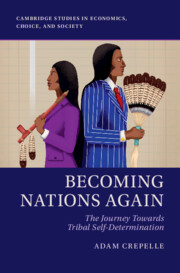Refine search
Actions for selected content:
128 results
Indonesia’s Criminal Justice System: A Case Study of Inter-Agency Conflict and the Fight for Power
-
- Journal:
- Asian Journal of Law and Society , First View
- Published online by Cambridge University Press:
- 07 October 2025, pp. 1-27
-
- Article
- Export citation
3 - Peace and Justice Hand-in-Hand
-
- Book:
- Governing the Past
- Published online:
- 30 July 2025
- Print publication:
- 07 August 2025, pp 65-94
-
- Chapter
- Export citation
1 - Introduction to Volume III
-
-
- Book:
- Core Concepts in Criminal Law and Criminal Justice
- Published online:
- 09 July 2025
- Print publication:
- 24 July 2025, pp 1-10
-
- Chapter
- Export citation
8 - Beyond a Reasonable Doubt and Intime Conviction
- from Part II - Criminal Procedure
-
-
- Book:
- Core Concepts in Criminal Law and Criminal Justice
- Published online:
- 09 July 2025
- Print publication:
- 24 July 2025, pp 263-304
-
- Chapter
- Export citation
Nigerian Criminology and the United Nations Sustainable Development Goals: Challenges, Opportunities and Directions
-
- Journal:
- International Annals of Criminology , First View
- Published online by Cambridge University Press:
- 21 July 2025, pp. 1-20
-
- Article
- Export citation
Supreme Prejudice: Examining the Supreme Court’s Racial & Criminal Biases
-
- Journal:
- Journal of Race, Ethnicity and Politics / Volume 10 / Issue 3 / November 2025
- Published online by Cambridge University Press:
- 16 July 2025, pp. 791-813
-
- Article
-
- You have access
- Open access
- HTML
- Export citation
Does compulsory community treatment for discharged forensic hospital patients work? The recent evidence base
-
- Journal:
- CNS Spectrums / Volume 30 / Issue 1 / 2025
- Published online by Cambridge University Press:
- 13 June 2025, e65
-
- Article
-
- You have access
- Open access
- HTML
- Export citation
23 - Moral Judgments about Retributive Vigilantism
- from Part III - Applications
-
-
- Book:
- The Cambridge Handbook of Experimental Jurisprudence
- Published online:
- 17 May 2025
- Print publication:
- 05 June 2025, pp 381-398
-
- Chapter
- Export citation
1 - Criminal Justice and the Metaphysical Animal
-
- Book:
- Rethinking Criminal Justice
- Published online:
- 17 May 2025
- Print publication:
- 05 June 2025, pp 1-24
-
- Chapter
- Export citation
US Attorney Declination Rates of Tribal Cases: Resources Matter!
-
- Journal:
- Journal of Race, Ethnicity and Politics / Volume 10 / Issue 2 / July 2025
- Published online by Cambridge University Press:
- 27 May 2025, pp. 263-276
-
- Article
-
- You have access
- Open access
- HTML
- Export citation
“Coming Out as Female Has Been a Gradual Process”: Combating Trans Necropolitical Governance in Canadian Corrections
-
- Journal:
- Canadian Journal of Law & Society / La Revue Canadienne Droit et Société / Volume 40 / Issue 1 / April 2025
- Published online by Cambridge University Press:
- 21 May 2025, pp. 98-121
-
- Article
-
- You have access
- Open access
- HTML
- Export citation
Exploring the links between punitiveness and political economy: Are criminal justice regimes a key dimension of varieties of capitalism in OECD countries?
-
- Journal:
- Journal of International and Comparative Social Policy / Volume 40 / Issue 2 / July 2024
- Published online by Cambridge University Press:
- 14 May 2025, pp. 215-232
-
- Article
-
- You have access
- Open access
- HTML
- Export citation
13 - Criminal Justice Crisis
- from Part II - Self-Determination Meets Paternalism
-
- Book:
- Becoming Nations Again
- Published online:
- 17 April 2025
- Print publication:
- 24 April 2025, pp 190-209
-
- Chapter
-
- You have access
- Open access
- HTML
- Export citation

Becoming Nations Again
- The Journey Towards Tribal Self-Determination
-
- Published online:
- 17 April 2025
- Print publication:
- 24 April 2025
-
- Book
-
- You have access
- Open access
- Export citation
Comparative Reflections on the Carlos Ghosn Case and Japanese Criminal Justice
-
- Journal:
- Asia-Pacific Journal / Volume 18 / Issue 24 / December 2020
- Published online by Cambridge University Press:
- 14 March 2025, e2
-
- Article
-
- You have access
- Open access
- Export citation
9 - Conclusion
-
- Book:
- Comprehensive Deterrence Theory
- Published online:
- 06 March 2025
- Print publication:
- 13 March 2025, pp 227-240
-
- Chapter
- Export citation
1 - Introduction
-
- Book:
- Comprehensive Deterrence Theory
- Published online:
- 06 March 2025
- Print publication:
- 13 March 2025, pp 1-13
-
- Chapter
- Export citation
2 - The Need for Reconceptualizing Deterrence Theory
-
- Book:
- Comprehensive Deterrence Theory
- Published online:
- 06 March 2025
- Print publication:
- 13 March 2025, pp 14-34
-
- Chapter
- Export citation
Intimate image abuse offences: stakeholder perspectives of the effectiveness of the new offences in Hong Kong
-
- Journal:
- Legal Studies / Volume 45 / Issue 2 / June 2025
- Published online by Cambridge University Press:
- 24 February 2025, pp. 192-211
- Print publication:
- June 2025
-
- Article
-
- You have access
- Open access
- HTML
- Export citation
Forensic assertive community treatment: an emerging best practice
-
- Journal:
- CNS Spectrums / Volume 30 / Issue 1 / 2025
- Published online by Cambridge University Press:
- 20 February 2025, e34
-
- Article
-
- You have access
- Open access
- HTML
- Export citation
